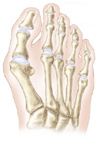 How is a bunion diagnosed? How is a bunion diagnosed?
When the patient stands with the weight evenly distributed, the bunion is evident as a bony growth protruding from the metatarsal head at the base of the great toe, which is angled in toward the other toes. Sometimes the pressure against the second toe causes it to deform into a "hammer toe" . This condition may be more painful than the bunion itself, and can occasionally cause the second toe to partially dislocate. This can lead to the formation of a callus (transfer lesion) under the metatarsal head, which can be very painful. X-rays can reveal the extent to which the second toe is dislocated. |





